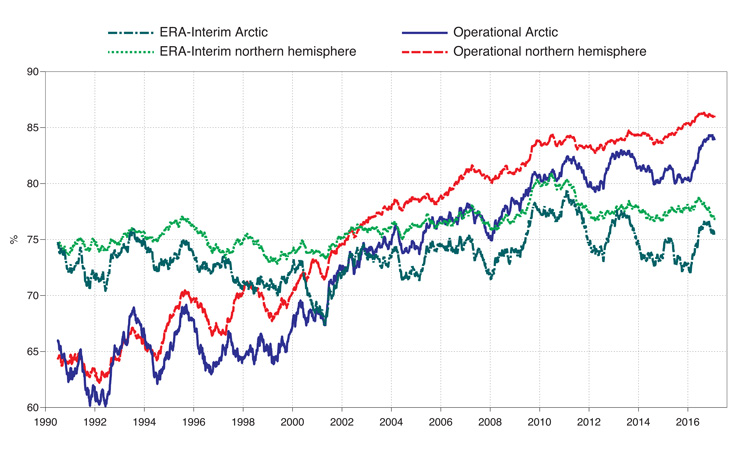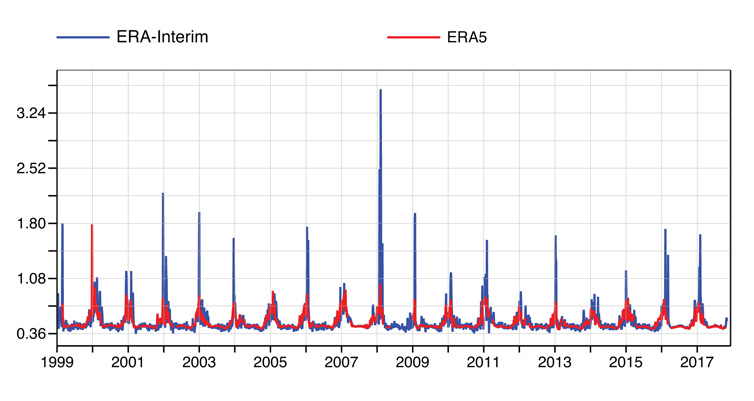 |
 |
Irina Sandu, Physical Processes Team Leader, and Peter Bauer, Deputy Director of Research.
Polar regions are expected to respond to climate change more strongly than lower latitudes due to “polar amplification”. One of the most visible changes has been the recent decline in summer sea-ice extent in the Arctic. This has created a current focus on polar research to monitor these rapid changes more accurately and enhance predictive skill from days to decades – right at the interface between weather and climate prediction.
The weather and climate community recognise the priority of polar prediction research, which features highly on the agenda of the World Meteorological Organization (WMO). As part of its Polar Prediction Project (PPP), the WMO is running a Year of Polar Prediction (YOPP) from mid-2017 to mid-2019 which involves an intensive period of observation, modelling, verification and other activities. YOPP’s first Special Observing Period (SOP) just finished in the Arctic, gathering almost 2000 extra observations during an eight-week period. Compared with previous similar initiatives, YOPP is putting additional emphasis on numerical experimentation, in a concerted effort to:
- exploit observations for model improvement and
- drive developments in data assimilation and the design of observing systems.
The European Commission’s Horizon 2020 funding framework has allocated significant resources in support of polar prediction research. At present, there are three major Horizon 2020 projects (APPLICATE, BLUE ACTION and INTAROS) contributing to PPP and YOPP with a total funding of €32.5 million over four years.
ECMWF contributes to polar prediction activities in several ways. For example, we are one of the main partners in APPLICATE and a partner in other relevant H2020 projects. ECMWF is also contributing to APPLICATE and YOPP with an open data portal providing ECMWF analyses and coupled atmosphere-ocean-sea ice forecasts from 2017 to 2019 and by providing model data at key observational sites (through the main YOPP data portal). The ECMWF YOPP dataset contains both regular forecast output and tendencies from the different physical processes, which are not usually stored. This global dataset is also highly relevant for other communities focusing on non-polar aspects of weather and climate, continuing the heritage of the ECMWF dataset released in support of the Year of Tropical Convection (YOTC).
Attending the recent 9th PPP Steering Group meeting (Figure 1) provided an opportunity to consider the challenges involved in polar prediction and the research priorities for ECMWF.
 Figure 1: 9th meeting of the PPP Steering Group, chaired by Prof. Thomas Jung (AWI), took place at the Icelandic Meteorological Office in Reykjavik. ECMWF was represented by Irina Sandu and Jonathan Day. Discussions covered many topics including YOPP Special Observing Periods, observing system experiments, observational supersites and their use for understanding model errors. (Photo: Snorri Zóphóníasson, Icelandic Meteorological Office)
Figure 1: 9th meeting of the PPP Steering Group, chaired by Prof. Thomas Jung (AWI), took place at the Icelandic Meteorological Office in Reykjavik. ECMWF was represented by Irina Sandu and Jonathan Day. Discussions covered many topics including YOPP Special Observing Periods, observing system experiments, observational supersites and their use for understanding model errors. (Photo: Snorri Zóphóníasson, Icelandic Meteorological Office)
What are the polar prediction-related challenges and priorities for ECMWF?
Although medium-range weather forecasts in the Arctic have improved in recent years following the general trend of skill evolution of approximately one day per decade (Bauer et al., 2015), the skill remains lower than in mid-latitudes (Figure 2). Global reanalyses have also improved considerably over recent years, and high-resolution global reanalyses such as ERA5 (32 km resolution) can now be used to monitor the Arctic climate and its changes.
In order to improve both predictions in the Arctic on timescales from a few hours to seasons and reanalysis, ECMWF needs to invest work in three areas:
- enhanced coupled modelling,
- data assimilation methods and
- the effective use of observations in the numerical weather prediction (NWP) system.
Arctic regions pose specific challenges for each of these three areas because model errors are large, in-situ observations are sparse, and satellite observations are difficult to use in data assimilation because of ambiguous signal properties, despite large data volumes. Also, our data assimilation systems are mostly tuned to perform optimally in mid-latitudes, and we first need to understand their suitability around the poles.

Figure 2: Evolution of the anomaly correlation of 500 hPa geopotential height at forecast day 6, for the northern hemisphere and for the Arctic (60-90N) in the ECMWF operational system, and in the ERA-Interim reanalysis.
Modelling
The key challenges identified are related to the representation of stable boundary layers, mixed-phase clouds, snow and sea ice, plus the coupling of these different elements of the Earth system. Currently, erroneous fluxes of heat, momentum and radiation at the interfaces can occur, for example.
Mixed-phase cloud research at ECMWF has improved the partition between liquid and ice phase (among other improvements), which is very important for capturing cloud radiative effects, and for correctly predicting near-surface temperatures (Forbes, ECMWF Newsletter, no 146).
Within APPLICATE, we are looking at the realistic representation of snow in our model, aiming to operationally implement a multi-layer snow scheme instead of the bulk snow scheme used at the moment in the Integrated Forecasting System (IFS). This would improve the representation of the snow-to-atmosphere coupling, which is one of the key elements for accurately forecasting near surface temperature (and its diurnal cycle) and snow evolution.
In APPLICATE, we are also focusing on the benefits of coupling between ocean, atmosphere and sea ice. Ocean and sea-ice models have only recently been added to NWP systems while they have been an integral component of climate models for some time. Coupling these elements together in weather forecasting brings opportunities, but also new challenges compared to climate prediction. It involves much shorter spatio-temporal scales, and model initialisation needs to take these couplings into account. Different initialisation methods for sea ice and snow are being explored in the APPLICATE and SPICES projects to see how they affect predictability on sub-seasonal to seasonal timescales.
Targeted diagnostics and observational verification are used to pinpoint deficiencies in the representation of physical processes in the model. Observational sites with a wide range of measurements, also known as ‘supersites’, are particularly useful for disentangling the sources of model errors. We are contributing to an international intercomparison of NWP models at supersites in the Arctic as part of APPLICATE and PPP. This will help us evaluate coupled processes and identify model errors, such as the well-known warm bias in the IFS over Scandinavia (Figure 3). We are also paying special attention to extreme weather in the Arctic during YOPP such as:
- polar lows - small-scale and short-lived but very intense cyclones and
- heatwaves – which can cause persistent melting; increase the risk of landslides and disrupt local populations.

Figure 3: Air temperature (top) and snow/soil temperature (bottom) from ECMWF HRES forecasts (red) compared with in-situ data (blue) from the 50 m observing tower at Sodankyla, Finland, during atmospherically stable conditions. It shows a ~8°C bias in model air temperature near the surface. This is partly because of a lack of sensitivity in the current snow model, which only has a single layer (represented by the red dot in the lower panel). The interface between snow and soil is shown by the horizontal brown line. Fields are composites of situations with a strong boundary layer temperature inversion, where the observed temperature increases by more than 5°C in the lowest 50 m of the atmosphere.
Use of observations and data assimilation
There are also many challenges and opportunities related to observations at high latitudes. There are far fewer conventional observations (radiosondes, buoys) than in other regions, and it is harder to assimilate them because of large model errors as described above. The Arctic is well observed by polar-orbiting satellites, because of their high revisit time over polar areas. However, the observations are particularly difficult to use over such heterogeneous surfaces and in the shallow polar atmosphere. More specifically, we cannot yet make the best use of these observations because model errors in these regions are still large and because transforming the information obtained from satellites (radiances) into physical properties such as temperature or humidity that are used in models is more difficult than in other regions. These difficulties relate to the presence of clouds (and particularly mixed-phase clouds), to the lower atmosphere being shallow and often isothermal, and to the presence of snow and of sea-ice covered surfaces, which increases the uncertainty in the estimates of surface emissivity and temperature.
The quality of a forecast model is key for effective use of observations in data assimilation, highlighting the intimate link between modelling and data assimilation. This is well illustrated by the massively improved representation of Sudden Stratospheric Warmings in ERA5 with respect to ERA-Interim (Figure 4), which is primarily attributed to the improvements in the semi-Lagrangian advection scheme.

Figure 4. A comparison of microwave radiances measured by the NOAA-15 satellite and equivalent values simulated using the temperature fields of ERA-Interim (blue) and ERA5 (red). The standard deviation of differences is shown for channel 13 (53 GHz) which is primarily sensitive to altitudes around 5 hPa.
Work on data assimilation methodologies is also needed. For example, we know very little of how to deal with systematic errors and how reliable our estimates of model uncertainty are in polar areas. These aspects are important because they control how much weight is given to observations versus model in the data assimilation process, and bias correction is crucial for finding an optimal solution in variational assimilation.
It is important to understand whether existing observations (satellite or conventional) are used effectively in polar regions, and how much they contribute to reducing forecast errors in the current system. In the framework of APPLICATE, numerical experiments are used along with existing diagnostics of operational systems at ECMWF and other partners (AWI, Université Catholique de Louvain, UK Met Office, Météo-France) to understand which observations contribute most to the reductions in forecast error. The requirements for frequency and spatial distribution of key observations (e.g. radiosondes, buoys, sea ice thickness, from SMOS and Cryosat for example) also need to be known, so that network design, deployment programmes and satellite mission planning can be supported.
At ECMWF, we are performing a wide range of Observing System Experiments (OSE) to characterise the value of existing observations in the present system. In these OSE, we remove selected observing systems (microwave sounders, infrared sounders, conventional observations such as radiosondes, buoys, GPSRO, AMVs) north of 60°N and south of 60°S for several periods including some of the YOPP SOPs. Some of these experiments will focus particularly on documenting the impact of additional weather observations made as part of YOPP.
Acknowledgements
Polar prediction-related activities cover many aspects and involve expert work from many across all departments at ECMWF. In particular, we would like to thank Jonathan Day, Linus Magnusson, Manuel Fuentes, Richard Mladek, Heather Lawrence, Niels Bormann, Mohamed Dahoui, Tony McNally and Gabriele Arduini, Steffen Tietsche, as well as the PPP chair Prof. Thomas Jung and Kirstin Werner for inputs to this blog.
Banner image: Copyright: 2015 EUMETSAT
